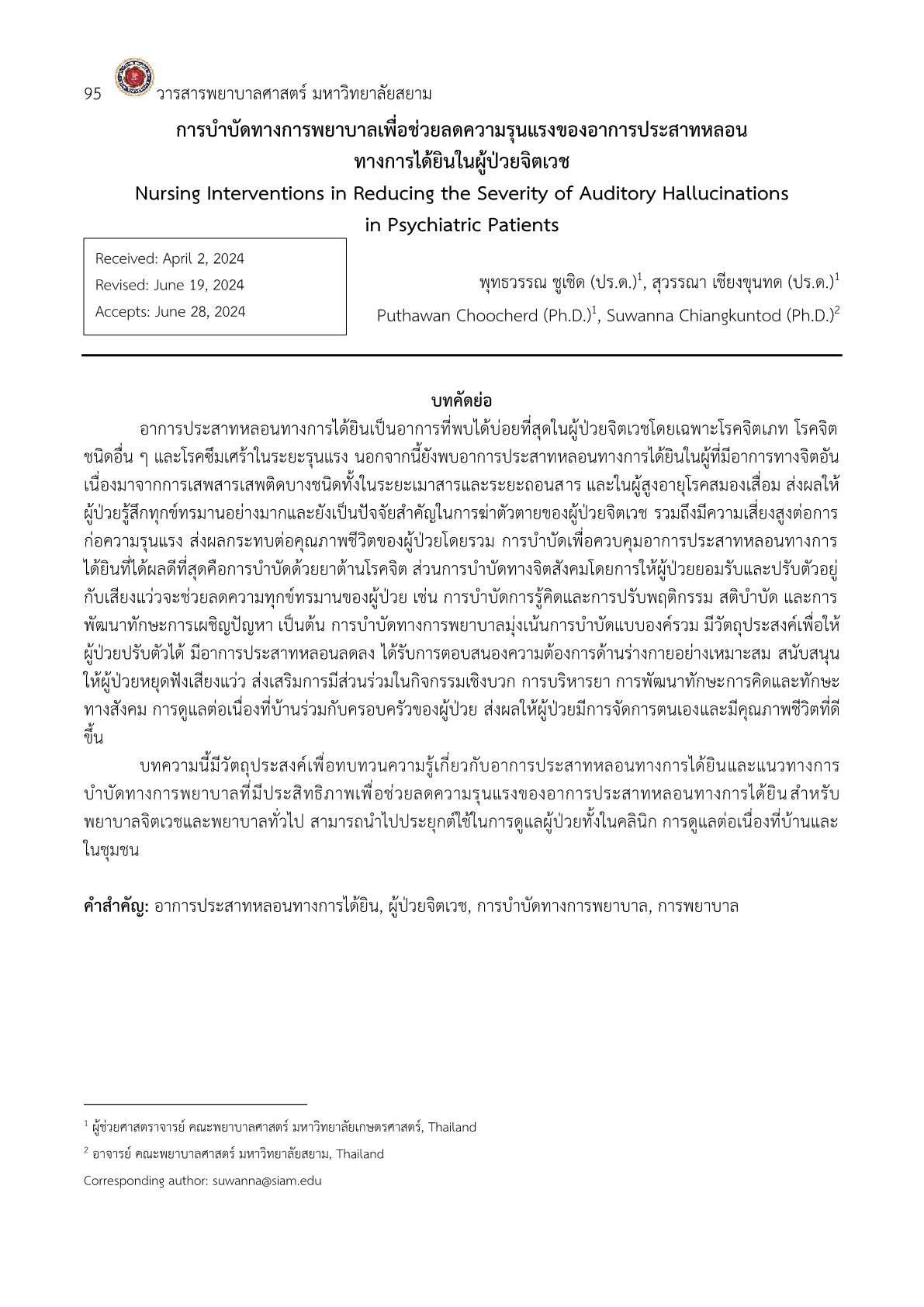การบำบัดทางการพยาบาลเพื่อช่วยลดความรุนแรงของอาการประสาทหลอน ทางการได้ยินในผู้ป่วยจิตเวช
คำสำคัญ:
อาการประสาทหลอนทางการได้ยิน, ผู้ป่วยจิตเวช, การบำบัดทางการพยาบาล, การพยาบาลบทคัดย่อ
อาการประสาทหลอนทางการได้ยินเป็นอาการที่พบได้บ่อยที่สุดในผู้ป่วยจิตเวชโดยเฉพาะโรคจิตเภท โรคจิตชนิดอื่น ๆ และโรคซึมเศร้าในระยะรุนแรง นอกจากนี้ยังพบอาการประสาทหลอนทางการได้ยินในผู้ที่มีอาการทางจิตอันเนื่องมาจากการเสพสารเสพติดบางชนิดทั้งในระยะเมาสารและระยะถอนสาร และในผู้สูงอายุโรคสมองเสื่อม ส่งผลให้ผู้ป่วยรู้สึกทุกข์ทรมานอย่างมากและยังเป็นปัจจัยสำคัญในการฆ่าตัวตายของผู้ป่วยจิตเวช รวมถึงมีความเสี่ยงสูงต่อการก่อความรุนแรง ส่งผลกระทบต่อคุณภาพชีวิตของผู้ป่วยโดยรวม การบำบัดเพื่อควบคุมอาการประสาทหลอนทางการ ได้ยินที่ได้ผลดีที่สุดคือการบำบัดด้วยยาต้านโรคจิต ส่วนการบำบัดทางจิตสังคมโดยการให้ผู้ป่วยยอมรับและปรับตัวอยู่กับเสียงแว่วจะช่วยลดความทุกข์ทรมานของผู้ป่วย เช่น การบำบัดการรู้คิดและการปรับพฤติกรรม สติบำบัด และการพัฒนาทักษะการเผชิญปัญหา เป็นต้น การบำบัดทางการพยาบาลมุ่งเน้นการบำบัดแบบองค์รวม มีวัตถุประสงค์เพื่อให้ผู้ป่วยปรับตัวได้ มีอาการประสาทหลอนลดลง ได้รับการตอบสนองความต้องการด้านร่างกายอย่างเหมาะสม สนับสนุนให้ผู้ป่วยหยุดฟังเสียงแว่ว ส่งเสริมการมีส่วนร่วมในกิจกรรมเชิงบวก การบริหารยา การพัฒนาทักษะการคิดและทักษะทางสังคม การดูแลต่อเนื่องที่บ้านร่วมกับครอบครัวของผู้ป่วย ส่งผลให้ผู้ป่วยมีการจัดการตนเองและมีคุณภาพชีวิตที่ดีขึ้น
บทความนี้มีวัตถุประสงค์เพื่อทบทวนความรู้เกี่ยวกับอาการประสาทหลอนทางการได้ยินและแนวทางการบำบัดทางการพยาบาลที่มีประสิทธิภาพเพื่อช่วยลดความรุนแรงของอาการประสาทหลอนทางการได้ยินสำหรับพยาบาลจิตเวชและพยาบาลทั่วไป สามารถนำไปประยุกต์ใช้ในการดูแลผู้ป่วยทั้งในคลินิก การดูแลต่อเนื่องที่บ้านและในชุมชน
เอกสารอ้างอิง
ณัฐิกา ราชบุตร และสุริยา ราชบุตร. (2561). การบำบัดด้วยแนวคิดการปรับเปลี่ยนความคิดและพฤติกรรมในผู้ป่วยโรคจิตเภท: การทบทวนงานวิจัยเพื่อใช้ในการปฏิบัติในประเทศไทย.วารสารโรงพยาบาลสกลนคร, 21(1), 163-177.
ณัทธร พิทยรัตน์เสถียร. (2565). Basic skills in CBT. กรุงเทพ: สำนักพิมพ์จุฬาลงกรณ์มหาวิทยาลัย.
ธนพล บรรดาศักดิ์. (2564). บทบาทพยาบาลในการดูแลผู้ป่วยโรคจิตเภท: กรณีศึกษา. เวชสารแพทย์ทหารบก, 74(3):221-232.
ปภาจิต บุตรสุวรรณ, สกาวรัตน์ พวงลัดดา, รัตน์ดา นราภักดิ์, และพุทธวรรณ ชูเชิด. (2566). ผลของโปรแกรมสติบำบัดเพื่อลดความรุนแรงของอาการประสาทหลอนทางหูในผู้ป่วยจิตเภท. วารสารพุทธจิตวิทยา, 8(2), 168-181.
พฤทธิ์ ทองเพ็งจันทร์, และอัจฉรา วิไลสกุลยง. (2564). คู่มือแนวทางการส่งต่อผู้ป่วยวิกฤตสุขภาพจิตและสารเสพติด สำนักงานปลัดกระทรวงสาธารณสุข. นนทบุรี: กองบริหารการสาธารณสุข สำนักงานปลัดกระทรวงสาธารณสุข.
สรวงพร กุศลส่ง และมนสิช สิทธิสมบูรณ์. (2560).
การพัฒนารูปแบบการเรียนการสอนที่ส่งเสริมยุทธวิธีการรู้คิดสำหรับนักศึกษามหาวิทยาลัยราชภัฏ. วารสารศึกษาศาสตร์ มหาวิทยาลัยนเรศวร, 19(1), 114-130.
พิมพ์ชนา ศิริเหมอนนต์, อัจฉราพร สี่หิรัญวงศ์, และอทิตยา พรชัยเกตุ โอว ยอง. (2555). การบำบัดการรู้คิด-ปรับพฤติกรรมเพื่อลดอาการทางบวกในผู้ป่วยจิตเภท: การทบทวนหลักฐานเชิงประจักษ์เพื่อใช้ในการปฏิบัติ. วารสารสมาคมจิตแพทย์แห่งประเทศไทย, 57(2): 235-248.
มาโนช หล่อตระกูล, และปราโมทย์ สุคนิชย์. (2558). จิตเวชศาสตร์ รามาธิบดี (พิมพ์ครั้งที่ 4 ฉบับเรียบเรียง). กรุงเทพฯ: ภาควิชาจิตเวชศาสตร์ คณะแพทยศาสตร์โรงพยาบาลรามาธิบดี มหาวิทยาลัยมหิดล.
เสาวลักษณ์ สุวรรณไมตรี, อนงค์นุช ศาโศรก, ธนเนตร ฉันทลักษณ์วงศ์, ชุรีภรณ์ เสียงล้ำ, และวีร์ เมฆวิลัย (บ.ก.). (2559). คู่มือการดูแลผู้ป่วยโรคจิตเภทสำหรับโรงพยาบาลในเขตสุขภาพ (ฉบับพยาบาล/นักวิชาการสาธารณสุข) พิมพ์ครั้งที่ 2. นนทบุรี: กรมสุขภาพจิต กระทรวงสาธารณสุข.
Abdelraof, A., Hamed, S., & Abd ELhay, E. (2023). The impact of auditory hallucinations severity on social skills and depressive symptoms among schizophrenic patients. Mansoura Nursing Journal, 10(1), 155-166. doi: 10.21608/mnj.2023.320383
American Psychiatric Association [APA]. (2013). Diagnostic and statistical manual of mental disorders (DSM 5). Arlington, VA: APA.
Beck, A.T., Wright, F.D., Newman, C.F. & Liese, B.S. (1993). Cognitive therapy of substance abuse. New York: The Guilford Press.
Bergmann, N., Hahn, E., Hahne, I., Zierhut, M., Ta, T. M. T., Bajbouj, M., Pijnenborg, G. H. M., & Böge, K. (2021). The relationship between mindfulness, depression, anxiety, and quality of life in individuals with schizophrenia spectrum disorders. Frontiers in psychology, 12, 708808. https://doi.org/10.3389/fpsyg.2021.708808
Brand, R. M., Badcock, J. C., & Paulik, G. (2022). Changes in positive and negative voice content in cognitive-behavioural therapy for distressing voices. Psychology and psychotherapy, 95(3), 807–819. https://doi.org/10.1111/papt.12399
Buccheri, R. K., Trygstad, L. N., Buffum, M. D., Birmingham, P., & Dowling, G. A. (2013). Self-management of unpleasant auditory hallucinations: a tested practice model. Journal of psychosocial nursing and mental health services, 51(11), 26–34. https://doi.org/10.3928/02793695-20130731-02
Chadwick, P., Strauss, C., Jones, A. M., Kingdon, D., Ellett, L., Dannahy, L., & Hayward, M. (2016). Group mindfulness-based intervention for distressing voices: A pragmatic randomized controlled trial. Schizophrenia research, 175(1-3), 168–173. https://doi.org/10.1016/j.schres.2016.04.001
Darrell-Berry, H., Berry, K., & Bucci, S. (2016). The relationship between paranoia and aggression in psychosis: A systematic review. Schizophrenia research, 172(1-3), 169–176. https://doi.org/10.1016/j.schres.2016.02.009
Daryanto D., Irfan A., & Triana S. M. (2023). Effect of psycho-education enrichment on family's ability to control hallucinations in people with schizophrenia: pre-experimental study. Health Education & Health Promotion, 11(1), 111-116.
Deborah L. Ellison, Cynthia K. Meyer. (2020). Presence and therapeutic listening. Nursing Clinics of North America, 55(4), 457-465.
El Ashry, A. M. N., Abd El Dayem, S. M., & Ramadan, F. H. (2021). Effect of applying “acceptance and commitment therapy” on auditory hallucinations among patients with schizophrenia. Archives of psychiatric nursing, 35(2), 141–152. https://doi.org/10.1016/j.apnu.2021.01.003
Eversfield, C. L., & Orton, L. D. (2019). Auditory and visual hallucination prevalence in
Parkinson’s disease and dementia with Lewy bodies: a systematic review and meta-analysis. Psychological Medicine, 49(14), 2342–2353. doi:10.1017/S0033291718003161
Firdaus, R., Hernawaty, T., Suryani, S., & Banda, strategies - A case study on adolescents with hearing hallucinations. The Journal of Palembang Nursing Studies, 2(3), 186–195. https://doi.org/10.55048/jpns89
Frei, K., & Truong, D. D. (2017). Hallucinations and the spectrum of psychosis in Parkinson's disease. Journal of the neurological sciences, 374, 56–62. https://doi.org/10.1016/j.jns.2017.01.014
Gonçalves, P.D., Sampaio, F.M., da Cruz Sequeira, C.A., & Paiva e Silva, M.A. (2021). Nursing process addressing the nursing focus “hallucination”: A scoping review. Clinical Nursing Research, 30, 392 - 400.
Hochheiser, J., Lundin, N. B., & Lysaker, P. H. (2020). The Independent Relationships of Metacognition, Mindfulness, and Cognitive Insight to Self-Compassion in Schizophrenia. The Journal of nervous and mental disease, 208(1), 1–6. https://doi.org/10.1097/NMD.0000000000001065
Ibrahim, M., & Samiaji. (2021). The effectiveness of drawing occupation therapy on the ability to control hallucinations in schizophrenia: literature review. KnE Life Sciences, 6(1), 635-641. https://doi.org/10.18502/kls.v6i1.8737
Knott, V., Wright, N., Shah, D., Baddeley, A., Bowers, H., de la Salle, S., & Labelle, A. (2020). Change in the neural response to auditory deviance following cognitive therapy for hallucinations in patients with schizophrenia. Frontiers in psychiatry, 11,555. https://doi.org/10.3389/fpsyt.2020.00555
Pandarakalam, J. P. (2016). Pharmacological and non-pharmacological interventions for persistent auditory hallucinations in schizophrenia. British journal of medical practitioners, 9(2), 1-8.
Sari, L., & Sriati, A. (2023). Interventions to challenge auditory hallucinations through strengthening coping and motivation in patients with schizophrenia: case report. MAHESA: Malahayati Health Student Journal, 3(10), 3234-3247. doi:https://doi.org/10.33024/mahesa.v3i10.11177
Trygstad, L. N., Buccheri, R. K., Buffum, M. D., Ju, D. S., & Dowling, G. A. (2015). Auditory hallucinations interview guide: promoting recovery with an interactive assessment tool. Journal of psychosocial nursing and mental health services, 53(1), 20–28. https://doi.org/10.3928/02793695-20141203-01
Tsang, A., Bucci, S., Branitsky, A., Kaptan, S., Rafiq, S., Wong, S., Berry, K., & Varese, F. (2021). The relationship between appraisals of voices (auditory verbal hallucinations) and distress in voice-hearers with schizophrenia-spectrum diagnoses: A meta-analytic review. Schizophrenia research, 230, 38–47. https://doi.org/10.1016/j.schres.2021.02.013
Turkington, D., Lebert, L., & Spencer, H. (2016). Auditory hallucinations in schizophrenia: helping patients to develop effective coping strategies. BJPsych Advances, 22(6), 391–396. doi:10.1192/apt.bp.115.015214
Turner, D. T., Burger, S., Smit, F., Valmaggia, L. R., & van der Gaag, M. (2020). What constitutes sufficient evidence for case formulation-driven CBT for psychosis? Cumulative meta-analysis of the effect on hallucinations and delusions.Schizophrenia bulletin, 46(5), 1072–1085. https://doi.org/10.1093/schbul/sbaa045
Witusik, A., & Pietras, T. (2019). Music therapy as a complementary form of therapy for mental disorders. Polski merkuriusz lekarski : organ Polskiego Towarzystwa Lekarskiego, 47(282), 240–243.

ดาวน์โหลด
เผยแพร่แล้ว
รูปแบบการอ้างอิง
ฉบับ
ประเภทบทความ
สัญญาอนุญาต
ลิขสิทธิ์ (c) 2024 วารสารพยาบาลศาสตร์ มหาวิทยาลัยสยาม

อนุญาตภายใต้เงื่อนไข Creative Commons Attribution-NonCommercial-NoDerivatives 4.0 International License.
เนื้อหาและข้อมูลที่เผยแพร่ในวารสารพยาบาลศาสตร์ มหาวิทยาลัยสยามถือเป็นข้อคิดเห็นและความรับผิดชอบของผู้นิพนธ์บทความโดยตรง
บทความ เนื้อหา ข้อมูล รูปภาพ ฯลฯ ที่ได้รับการเผยแพร่ในวารสารพยาบาลศาสตร์ มหาวิทยาลัยสยาม ถือเป็นลิขสิทธิ์ของวารสารพยาบาลศาสตร์ มหาวิทยาลัยสยาม หากบุคคลหรือหน่วยงานใดต้องการนำทั้งหมดหรือส่วนหนึ่งส่วนใดไปเผยแพร่หรือเพื่อกระทำการใด ๆ จะต้องอ้างอิงวารสารพยาบาลศาสตร์ มหาวิทยาลัยสยามทุกครั้ง


